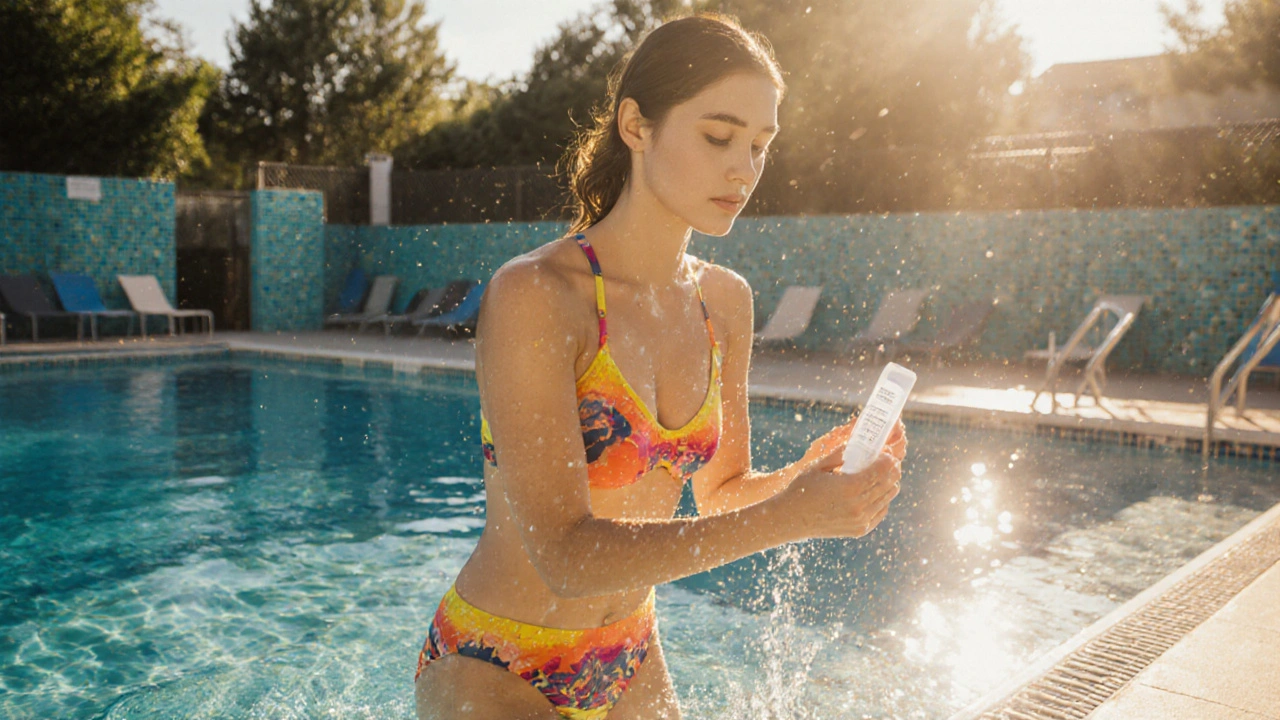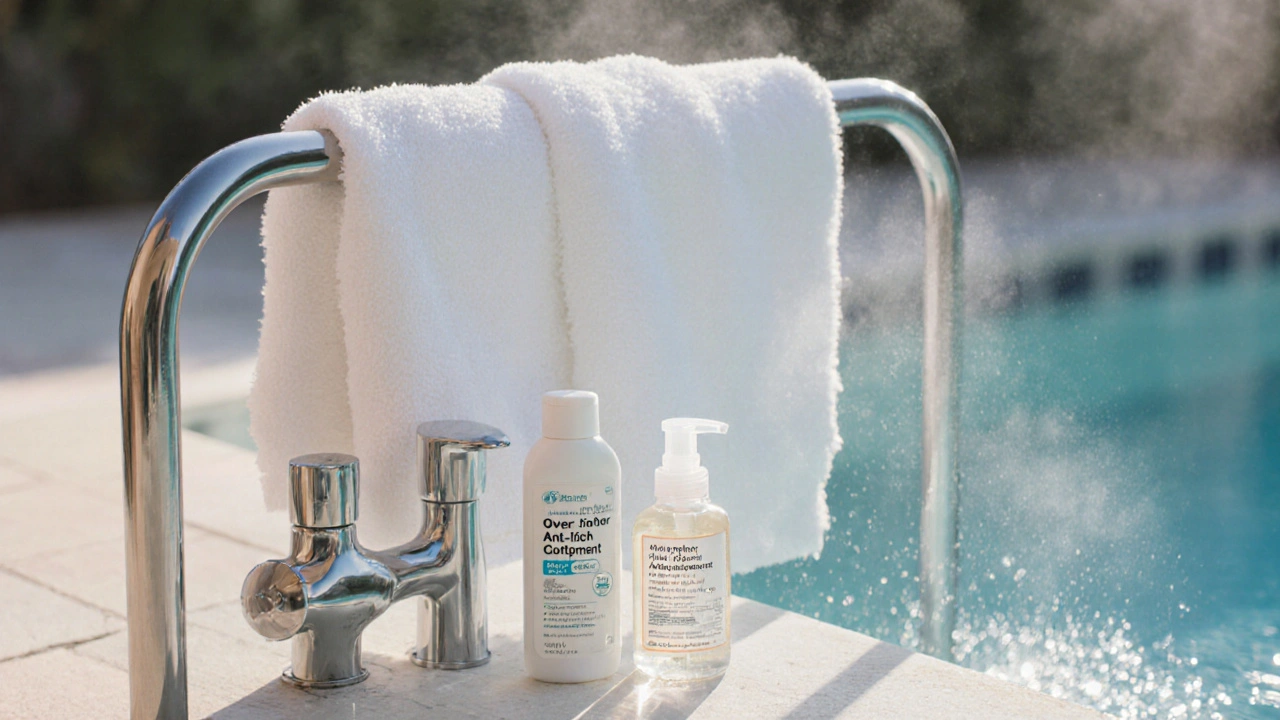Prevent and Treat Swimmer Skin Rashes - A Practical Guide
 Sep, 28 2025
Sep, 28 2025
Ever felt an itchy, red flare-up after a lap or a beach dip? You’re not alone. Swimmer's rash is a collective term for any irritation that shows up on the skin after exposure to pool or open‑water environments. It can range from a mild blotch to a painful inflammation that throws a wrench in your training routine. This guide walks you through the most common triggers, how to keep the rash at bay, and what to do when it does appear.
Quick Take
- Shower before and after every swim; rinse off chlorine, bacteria, and salt.
- Choose tight‑but‑breathable swimwear and rinse it after each use.
- Apply a thin layer of barrier cream (e.g., zincoxide) before hitting the water.
- For mild rashes, use a cool compress and an over‑the‑counter hydrocortisone cream.
- Seek medical help if redness spreads, oozes, or is accompanied by fever.
Identify the Common Culprits
Understanding the root cause helps you treat the problem without guessing. The most frequent offenders are:
- Chlorine - the disinfectant that keeps pools clean but can strip natural oils from the skin, leaving it dry and prone to irritation.
- Bacteria such as Pseudomonas aeruginosa, which thrives in warm, moist locker rooms and can cause “hot‑tube rash.” \n
- Fungal infection - think athlete's foot or jock itch that spreads when damp swimwear stays against the skin for too long.
- Eczema - pre‑existing dry, sensitive skin that reacts more violently to chemicals and friction.
- Sunburn - UV exposure weakens the skin barrier, making it easier for irritants to bite.
Prevention Strategies That Actually Work
These steps are backed by dermatology clinics across Australia and the U.S. They can be added to any swimmer’s routine without sacrificing performance.
| Action | Why It Helps | Frequency |
|---|---|---|
| Shower with mild, fragrance‑free cleanser | Removes chlorine, sweat, and microbes before they settle | Every swim session |
| Rinse immediately after exiting water | Reduces residual chlorine and salt that can irritate | Each time you leave the pool |
| Apply a thin layer of barrier cream (zincoxide or petrolatum) | Creates a protective film that blocks irritants | Before every swim |
| Use properly fitted, quick‑dry swimwear | Prevents chafing and limits moisture buildup | Every use |
| Change out of wet clothes within 30 minutes | Stops prolonged skin exposure to damp fabrics | After each session |
| Keep locker rooms ventilated; use anti‑fungal spray on surfaces | Limits bacterial and fungal reservoirs | Daily |
Everyday Hygiene Routine
Beyond the pool, your skin’s health depends on what you do at home.
- Moisturize within three minutes of showering. Look for products containing ceramides or hyaluronic acid - they replenish the barrier that chlorine strips away.
- Use a gentle, pH‑balanced body wash. Avoid scented soaps that can aggravate sensitive skin.
- Dry your feet thoroughly, especially between toes. A quick dab with a clean towel prevents fungal spores from taking hold.

Over‑the‑Counter Treatments for Mild Rashes
If you wake up with a red patch, you don’t have to panic. The following options work for most uncomplicated irritations.
- Hydrocortisone cream (1%) - reduces inflammation and itching. Apply a thin layer twice daily for up to seven days.
- Antihistamine tablets (e.g., cetirizine) - help control the itch‑scratch cycle if the rash is allergy‑driven.
- Calamine lotion - soothes heat and mild chemical burns with a cooling effect.
- For suspected fungal spots, an OTC topical antifungal (e.g., clotrimazole) applied twice daily usually clears the infection within a week.
Always follow the product’s instructions and discontinue use if the rash worsens.
When to Call a Professional
Some rashes need more than a quick fix. Seek medical advice if you notice any of the following:
- Rapid spreading of redness or the development of pus‑filled blisters.
- Swelling, fever, or chills - signs of a possible infection.
- Persistent itching that interferes with sleep or training for more than a week.
- Rash that resurfaces despite consistent prevention measures.
Dermatologists may prescribe a stronger topical corticosteroid, oral antibiotics, or recommend allergy testing to pinpoint hidden triggers.
Special Considerations for Different Swimmers
Competitive athletes often train multiple hours a day, so they should keep a spare set of clean swimwear in a waterproof bag and schedule brief “dry‑down” periods to let the skin breathe. Parents of kids should supervise locker‑room hygiene, teach children to towel‑dry before putting on swim trunks, and consider a weekly foot soak with diluted tea tree oil to prevent fungal build‑up. Open‑water enthusiasts need extra sun protection - a broad‑spectrum sunscreen that’s water‑resistant and a rash‑guard shirt can reduce both UV and salt irritation.
Frequently Asked Questions
Can I swim with a rash?
If the rash is mild and not oozing, you can usually swim, but you’ll want to protect the area with a waterproof barrier cream and rinse immediately after. Severe or infected rashes should be treated first to avoid spreading.
Why does chlorine cause itching?
Chlorine strips away the skin’s natural lipids, leaving the surface dry and more sensitive to irritants. The dehydration triggers nerve endings, creating that classic itch.
Is a rash after a hot‑tub session the same as a pool rash?
They’re similar but often have different culprits. Hot‑tub rashes are usually bacterial (Pseudomonas) due to warm, stagnant water, while pool rashes are more often chemical (chlorine) or fungal.
What’s the best barrier cream for swimmers?
A thin layer of zincoxide (15%) or plain petroleum jelly works well. Both create an occlusive film that resists chlorine and salt without feeling greasy.
How often should I replace my swimwear?
If you notice thinning fabric, persistent odor, or loss of elasticity, it’s time for a new set. For regular swimmers, swapping every 6‑12 months keeps the material effective.
Stacy McAlpine
September 28, 2025 AT 07:38Great guide! I love how you broke down the prevention steps into a simple checklist. The tip about changing out of wet clothes within 30 minutes is something I always forget, but it makes a huge difference. Also, the reminder to moisturize right after showering is gold for anyone with dry skin.
Rory Martin
September 28, 2025 AT 09:51While the advice is sound, few consider the hidden agenda behind chlorine manufacturers. The chemicals are engineered to weaken skin barriers, making us more dependent on their own proprietary creams. It is prudent to question whether the recommended barrier creams are truly independent solutions.
Roger Perez
September 28, 2025 AT 12:04👍 Absolutely! Staying proactive with a quick rinse and a dash of barrier cream can keep the itch at bay. Remember, every small habit compounds into healthier skin over time. 🌊 Keep it up and enjoy the water without worries!
michael santoso
September 28, 2025 AT 14:18Honestly, the checklist reads like a corporate wellness brochure. The emphasis on "properly fitted" swimwear seems more about selling high‑end gear than genuine care. A discerning swimmer should evaluate the necessity of each recommendation against personal experience.
M2lifestyle Prem nagar
September 28, 2025 AT 16:31Stay dry, stay healthy.
Karen Ballard
September 28, 2025 AT 18:44👍 This is super helpful! I always carry a small tube of petroleum jelly in my swim bag. It’s a cheap hack that works wonders against chlorine. 🌟
Gina Lola
September 28, 2025 AT 20:58From a performance standpoint, the recommended quick-dry fabrics mitigate chafing and reduce microbial load. Integrating a hydro-repellent finish can further attenuate the barrier disruption caused by prolonged exposure.
Leah Hawthorne
September 28, 2025 AT 23:11I’ve found that a gentle, fragrance‑free cleanser right after a swim keeps the skin from feeling stripped. Pair that with a lightweight moisturizer and you’re set for the next session. No need to overcomplicate the routine.
Brian Mavigliano
September 29, 2025 AT 01:24One might argue that the entire premise of "preventing" a rash is a myth perpetuated by a lucrative market of dermal products. Indeed, the so‑called "barrier creams" are merely occlusive agents that mask the underlying irritation rather than resolve it. Consider, if you will, that the skin’s innate barrier function is an evolutionary masterpiece designed to adapt to environmental stressors. By constantly applying artificial layers, we undermine this natural resilience, fostering a dependency that benefits manufacturers more than swimmers. Moreover, the emphasis on “changing out of wet clothes within thirty minutes” is an arbitrary time frame, lacking scientific consensus, yet it fuels consumer anxiety. If a swimmer neglects this window, the skin may develop a rash, but the causal chain is far more intricate, involving genetics, microbiome diversity, and even psychological stress. In other words, the simple checklist offered in the guide, while superficially useful, glosses over the complex interplay of factors that truly dictate dermatologic health. A more nuanced approach would encourage individuals to monitor their skin’s response, experiment with different fabrics, and perhaps even adopt a minimalist skincare regime. After all, the most profound protection may lie not in any commercial product but in the swimmer’s own awareness and adaptability.
Emily Torbert
September 29, 2025 AT 03:38Totally feel you on this. I’ve dealt with that itchy after‑pool feeling more times than I’d like to admit. The hydrocortisone tip works for me, but I also swear by a cool compress and a little aloe gel. It’s all about keeping the skin calm.
Rashi Shetty
September 29, 2025 AT 05:51While the guide is thorough, it fails to address the moral responsibility of pool operators to maintain optimal hygiene standards. It is unacceptable for facilities to neglect regular anti‑fungal treatments, thereby endangering swimmers. A truly comprehensive strategy must include accountability from the source, not just reactive measures by the individual.
Queen Flipcharts
September 29, 2025 AT 08:04In the spirit of national pride, it is essential that American swimmers champion home‑grown solutions. Trust in domestically produced barrier creams and locally formulated moisturizers; they are tailored for our climate and water standards. Relying on foreign products can undermine our competitive edge.
Yojana Geete
September 29, 2025 AT 10:18It is with profound regret that I must observe the gross negligence apparent in many aquatic facilities. The glaring absence of stringent sanitation protocols bespeaks a lamentable disregard for public health. One must, with all due solemnity, implore the authorities to rectify this egregious oversight forthwith.
Jason Peart
September 29, 2025 AT 12:31Hey team! Remember, if you get that itchy feeling, it's totally okay to take a brek and apply some aloe. Also, try to keep your gear dry as soon as you get out. Small steps = big comfort. Keep pushin'!
liam martin
September 29, 2025 AT 14:44In the grand tapestry of aquatic endeavors, one must contemplate the existential nature of a rash-does it signify weakness, or is it merely a reminder of our mortality in the chemical cauldron?
maya steele
September 29, 2025 AT 16:58Thank you for the comprehensive guide. As a health professional, I recommend swimmers adhere strictly to the pre‑ and post‑swim shower protocol and consider using a fragrance‑free moisturizer with ceramides. This approach aligns with dermatological best practices.